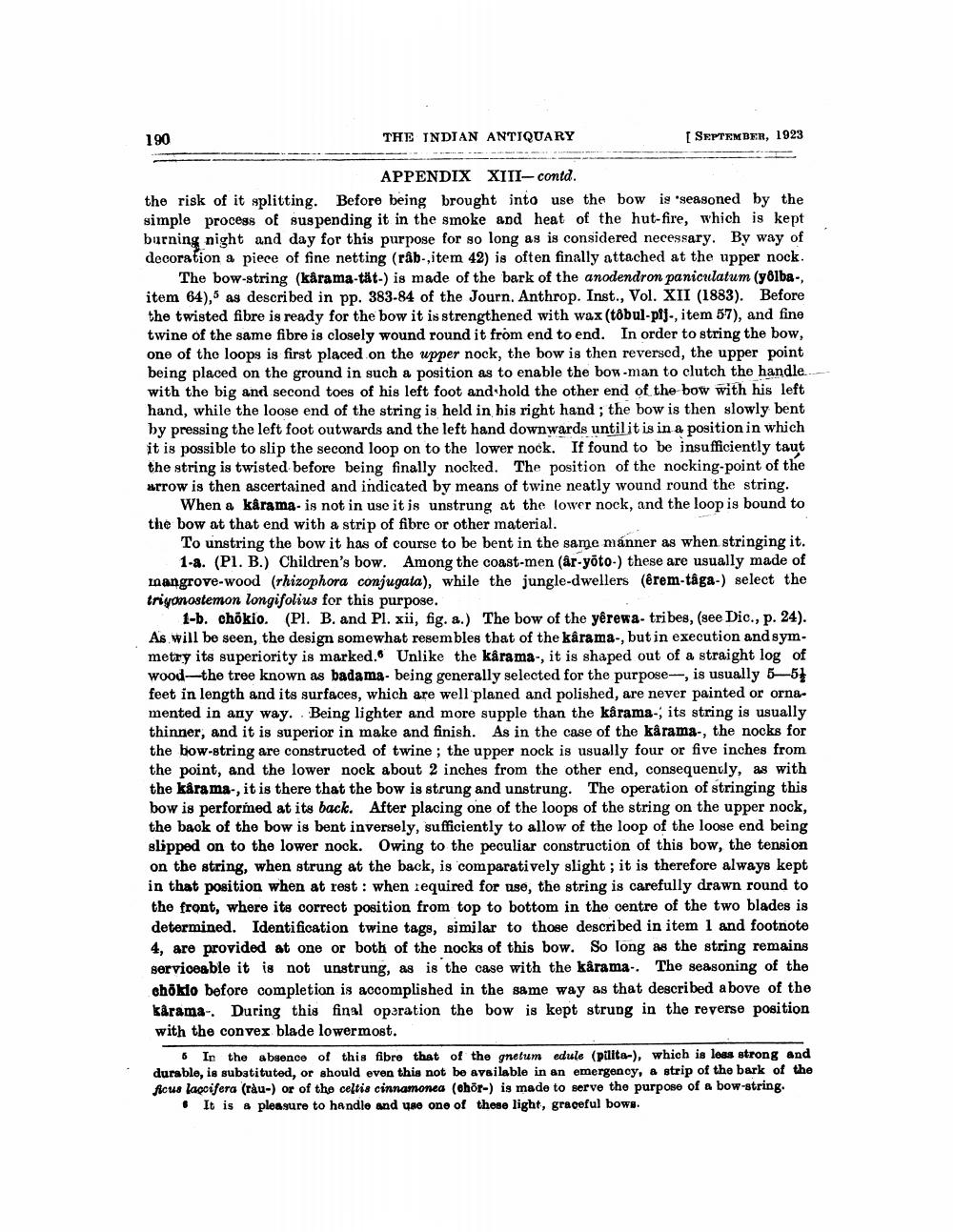________________
190
THE INDIAN ANTIQUARY
[SEPTEMBER, 1923
APPENDIX XIII-contd.
the risk of it splitting. Before being brought into use the bow is seasoned by the simple process of suspending it in the smoke and heat of the hut-fire, which is kept burning night and day for this purpose for so long as is considered necessary. By way of decoration a piece of fine netting (râb-,item 42) is often finally attached at the upper nock.
The bow-string (kârama-tät-) is made of the bark of the anodendron paniculatum (yolba-, item 64), as described in pp. 383-84 of the Journ. Anthrop. Inst., Vol. XII (1883). Before the twisted fibre is ready for the bow it is strengthened with wax (tôbul-pij-, item 57), and fine twine of the same fibre is closely wound round it from end to end. In order to string the bow, one of the loops is first placed on the upper nock, the bow is then reversed, the upper point being placed on the ground in such a position as to enable the bow-man to clutch the handle with the big and second toes of his left foot and hold the other end of the bow with his left hand, while the loose end of the string is held in his right hand; the bow is then slowly bent by pressing the left foot outwards and the left hand downwards until it is in a position in which it is possible to slip the second loop on to the lower nock. If found to be insufficiently taut the string is twisted before being finally nocked. The position of the nocking-point of the arrow is then ascertained and indicated by means of twine neatly wound round the string.
When a kârama- is not in use it is unstrung at the lower nock, and the loop is bound to the bow at that end with a strip of fibre or other material.
To unstring the bow it has of course to be bent in the same manner as when stringing it. 1-a. (Pl. B.) Children's bow. Among the coast-men (âr-yōto-) these are usually made of mangrove-wood (rhizophora conjugata), while the jungle-dwellers (êrem-tâga-) select the triyonostemon longifolius for this purpose.
1-b. chōkio. (Pl. B. and Pl. xii, fig. a.) The bow of the yêrewa- tribes, (see Dic., p. 24). As will be seen, the design somewhat resembles that of the kârama-, but in execution and symmetry its superiority is marked. Unlike the kârama-, it is shaped out of a straight log of wood-the tree known as badama- being generally selected for the purpose-, is usually 5-5 feet in length and its surfaces, which are well planed and polished, are never painted or ornamented in any way. Being lighter and more supple than the kârama-; its string is usually thinner, and it is superior in make and finish. As in the case of the kârama-, the nocks for the bow-string are constructed of twine; the upper nock is usually four or five inches from the point, and the lower nock about 2 inches from the other end, consequently, as with the kârama-, it is there that the bow is strung and unstrung. The operation of stringing this bow is performed at its back. After placing one of the loops of the string on the upper nock, the back of the bow is bent inversely, sufficiently to allow of the loop of the loose end being slipped on to the lower nock. Owing to the peculiar construction of this bow, the tension on the string, when strung at the back, is comparatively slight; it is therefore always kept in that position when at rest: when required for use, the string is carefully drawn round to the front, where its correct position from top to bottom in the centre of the two blades is determined. Identification twine tags, similar to those described in item 1 and footnote 4, are provided at one or both of the nocks of this bow. So long as the string remains serviceable it is not unstrung, as is the case with the kârama-. The seasoning of the chōklo before completion is accomplished in the same way as that described above of the karama-. During this final operation the bow is kept strung in the reverse position with the convex blade lowermost.
6 In the absence of this fibre that of the gnetum edule (pilita-), which is less strong and durable, is substituted, or should even this not be available in an emergency, a strip of the bark of the ficus laccifera (rau-) or of the celtis cinnamonea (ehör-) is made to serve the purpose of a bow-string.
It is a pleasure to handle and use one of these light, graceful bows.




